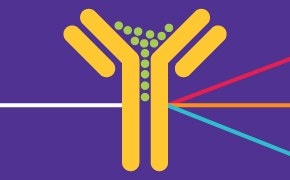Flow Cytometry

Flow cytometry is a technology that uses single or multiple lasers to provide a multi-parametric analysis of single cells. Each cell or particle is analyzed by visible light scatter or by fluorescence as cells rapidly flow past each laser. Independent of light scatter analysis, fluorescence measurements are achieved by transfection and expression of common fluorescent proteins (e.g. Green Fluorescent Protein, GFP) and staining with fluorescently conjugated antibodies or fluorescent dyes. Flow cytometry is a powerful technology that is commonly used in molecular and cellular biology research applications, including immunology, cancer biology, and disease research.
Featured Categories
Explore our selection of high-quality flow cytometry antibodies to find the right primary and secondary antibodies for your flow cytometry analysis research.
Experience ZooMAb® recombinant antibodies, engineered for exceptional consistency and performance in various applications.
Explore secondary antibody reagents and resources to help you choose the right secondary antibodies to make your next breakthrough.
Flow Cytometry Antibodies and Labels
Performing flow cytometry analysis involves using various flow cytometry antibodies and labels. Flow cytometry antibodies are used to specifically bind to different cell markers, helping to characterize the cell type and assess any changes in protein expression as part of the experiment. Numerous types of labels can be used to visualize the antibodies for detection in the flow cytometer depending on the experimental design including nucleic acid dyes, cell viability dyes, polymer dyes, quantum dots, small organic molecules, and fluorescent proteins. Antibodies are typically labeled through direct conjugation (either as commercially available products or conjugation kits allowing the end user to perform the reaction) or through the use of secondary antibodies.
Flow Cytometry Applications
Numerous fields of study use flow cytometry and often analyze multiple parameters within diverse populations of cells. Common molecular biology applications include analysis of recombinantly expressed fluorescent proteins that have induced expression in various cell types to elucidate gene function or for in vivo cell tracking. Whereas the staining of DNA allows for cell cycle analysis, the use of antibodies allow for a wide range of analyses including, signal transduction, RNA, and protein expression. However, immunophenotyping is one of most commonly used applications of flow cytometry. With immunophenotyping, fluorochrome-conjugated antibodies target multiple cell surface antigens to identify specific immune cells within population of cells.
Flow Cytometry Data Analysis
Flow cytometry data analysis often involves identifying a specific region of cells or cluster and applying additional parameters within the experiment, including investigating if additional cell identifying factors are present to gain further insight on cellular identity. Numerous computer software programs are available and commonly used to facilitate this kind of data analysis and other cell cycle analyses.
Flow Cytometry Instrumentation
A summary of the primary components used in flow cytometers includes electronics, optics, and fluidics. The fluidics serves as the liquid delivery system to direct the sample to the optic components, consisting of excitation optics (laser) and the collection optics that consist of photodiodes and photomultiplier tubes (PMTs). Importantly, the electronics components convert the information from the detectors into digital signals that are interpreted by computers. Combinations of additional systems facilitate more advanced sample analyses, including the use of cell sorters to purify and collect samples, and imaging cytometers that combine both flow cytometry with fluorescence microscopy.
Visit our document search for data sheets, certificates and technical documentation.
Related Articles
- Uncover tips for multicolor flow cytometry experiments, including the challenges in multicolor flow cytometry, steps for how to build a multicolor flow cytometry panel, tandem dyes, and tools for multicolor assay design.
- Flow cytometry dye selection tips match fluorophores to flow cytometer configurations, enhancing panel performance.
- Troubleshooting guide offers solutions for common flow cytometry problems, ensuring improved analysis performance.
- Available Fluorescent in situ hybridization (FISH) procedures, reagents and equipment.
- Fluorescence lifetime measurement is advantageous over intensity-based measurements. Applications include fluorescence lifetime assays, sensing and FLI.
- See All (10)
Related Protocols
- Explore our flow cytometry guide to uncover flow cytometry basics, traditional flow cytometer components, key flow cytometry protocol steps, and proper controls.”
- Learn key steps in flow cytometry protocols to make your next flow cytometry experiment run with ease.
- Immunofluorescence Protocol details Prestige Antibodies' subcellular localization studies in A-431, U-2 OS, and U-251MG cell lines.
- View instructional videos and download User Manuals for Milli-Q® SQ 2Series lab water systems. You’ll be up and running in no time. Buy online systems, accessories, cartridges and services.
- How to stain organoids? A complete step-by-step protocol for immunofluorescent (IF) and immunocytochemical (ICC) staining of organoid cultures using antibodies
- See All (6)
Find More Articles and Protocols
How Can We Help
In case of any questions, please submit a customer support request
or talk to our customer service team:
Email custserv@sial.com
or call +1 (800) 244-1173
Additional Support
- Chromatogram Search
Use the Chromatogram Search to identify unknown compounds in your sample.
- Calculators & Apps
Web Toolbox - science research tools and resources for analytical chemistry, life science, chemical synthesis and materials science.
- Customer Support Request
Customer support including help with orders, products, accounts, and website technical issues.
- FAQ
Explore our Frequently Asked Questions for answers to commonly asked questions about our products and services.
To continue reading please sign in or create an account.
Don't Have An Account?


